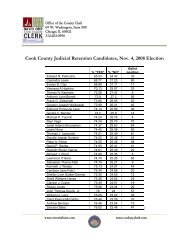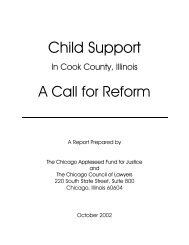Videoconferencing in Removal Hearings: A Case Study of the ...
Videoconferencing in Removal Hearings: A Case Study of the ...
Videoconferencing in Removal Hearings: A Case Study of the ...
Create successful ePaper yourself
Turn your PDF publications into a flip-book with our unique Google optimized e-Paper software.
angles or screen size will distort perceptions <strong>of</strong> a witness’s affect. 25 Crim<strong>in</strong>al defendants,<br />
who lack make-up, coach<strong>in</strong>g, and w<strong>in</strong>n<strong>in</strong>g wardrobes, are unlike <strong>the</strong> photogenic persons<br />
we are accustomed to see<strong>in</strong>g on television, and this disconnect with one’s expectations<br />
has <strong>the</strong> potential to impact decision-makers’ perceptions negatively. 26 A defendant<br />
Studies confirm that<br />
people evaluate those with<br />
whom <strong>the</strong>y work face-t<strong>of</strong>ace<br />
more favorably than<br />
those with whom <strong>the</strong>y<br />
work over a video<br />
connection.<br />
appear<strong>in</strong>g from a remote facility (<strong>of</strong>ten <strong>in</strong>side a prison)<br />
may not exhibit <strong>the</strong> demeanor one expects <strong>in</strong> a<br />
courtroom. 27 Studies, moreover, confirm that people<br />
evaluate those with whom <strong>the</strong>y work face-to-face more<br />
favorably than those with whom <strong>the</strong>y work over a video<br />
connection. 28 Studies <strong>in</strong>dicate that fact-f<strong>in</strong>ders empathize more with live witnesses, 29 and<br />
that decision makers are less likely to be sensitive to <strong>the</strong> impact <strong>of</strong> negative decisions on<br />
physically remote persons. 30 F<strong>in</strong>ally, commentators have po<strong>in</strong>ted to <strong>the</strong> possibility that<br />
videoconferenc<strong>in</strong>g may make it more difficult for crim<strong>in</strong>al defendants to understand what<br />
is happen<strong>in</strong>g <strong>in</strong> court, add<strong>in</strong>g yet ano<strong>the</strong>r level <strong>of</strong> marg<strong>in</strong>alization for people who are<br />
25 Poul<strong>in</strong>, supra note 24, at 1108-10.<br />
26 Id. at 1112-13, 1127-28.<br />
27 Id. at 1125.<br />
28 Gene D. Fowler & Marilyn E. Wackerbarth, Audio Teleconferenc<strong>in</strong>g Versus Face-to-face Conferenc<strong>in</strong>g:<br />
A Syn<strong>the</strong>sis <strong>of</strong> <strong>the</strong> Literature, 44 W. J. Speech Comm. 236, 245 (1980); John Storck & Lee Sproull,<br />
Through a Glass Darkly: What Do People Learn <strong>in</strong> Videoconferences?, 22 Hum. Comm. Res. 197, 201<br />
(1995).<br />
29 Gail S. Goodman, et al., Face-to-Face Confrontation: Effects <strong>of</strong> Closed-Circuit Technology on<br />
Children’s Eyewitness Testimony and Jurors’ Decisions, 22 L. & Hum. Behav. 165, 195 (1998); Graham<br />
Davies, The Impact <strong>of</strong> Television on <strong>the</strong> Presentation and Reception <strong>of</strong> Children’s Testimony, 22 Int’l J.L.<br />
& Psychiatry 241, 248 (1999)<br />
30<br />
Stanley Milgram, Some Conditions <strong>of</strong> Obedience and Disobedience to Authority, 18 Hum. Rel. 57, 63-65<br />
(1965).<br />
18




